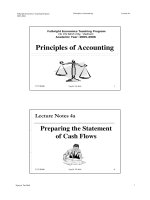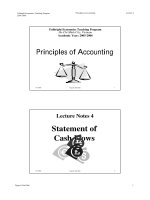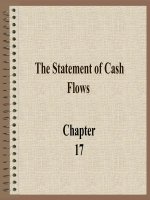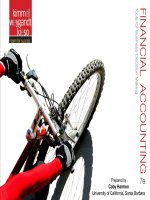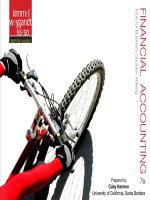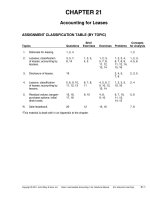Lecture Intermediate accounting (IFRS/e) - Chapter 21: The statement of cash flows revisited
Bạn đang xem bản rút gọn của tài liệu. Xem và tải ngay bản đầy đủ của tài liệu tại đây (1.14 MB, 39 trang )
21
Chapter 21
THE STATEMENT OF
CASH FLOWS
REVISITED
© 2013 The McGraw-Hill Companies, Inc.
CASH INFLOWS
Operating Activities
Cash received
from revenues
Investing Activities
Financing Activities
Sale of property, plant, and
Issuance of shares
equipment, and intangible assets Issuance of bonds
Sale of investments
and notes
Collections of loans
Business
Cash paid for
expenses
Purchase of property, plant, and Payment of dividends
equipment, and intangible assets
Repurchase of shares
Purchase of investments
Repayment of debt
Loans to others
CASH OUTFLOWS
21 - 2
Role of the Statement of Cash Flows
Helps
Helps users
users assess
assess .. .. ..
aa firm’s
firm’s ability
ability to
to generate
generate cash.
cash.
aa firm’s
firm’s ability
ability to
to meet
meet its
its
obligations.
obligations.
the
the reasons
reasons for
for differences
differences
between
between income
income and
and associated
associated
cash
cash flows.
flows.
the
the effect
effect of
of cash
cash and
and noncash
noncash
investing
investing and
and financing
financing activities
activities
on
on aa firm’s
firm’s financial
financial position.
position.
21 - 3
Role of the Statement of Cash Flows
Lists all cash inflows and
all cash outflows by
category: Operating,
Investing, and Financing
Explains the change in
cash during the period
Required by IFRS
21 - 4
Cash is King!
Especially during
an economic
downturn
Cash and Cash Equivalents
Resources
immediately
available to pay
obligations.
21 - 5
• Short-term, highly liquid
investments.
• Readily converted into
cash, with little or no risk of
loss.
• Examples: money market
funds, Treasury bills
• Maturity date must not be
longer than 3 months from
date of purchase.
Primary Elements of the Statement of
Cash Flows
Operating Activities
Investing Activities
Financing Activities
21 - 6
Reconciliation of the Net
Increase or Decrease in
Cash with the Change in
the Balance of the Cash
Accounts
Significant Noncash
Investing and Financing
Activities are disclosed
in the notes to the
financial statements.
Primary Elements of the Statement of
Cash Flows
21 - 7
Operating
Activities
Reports the cash effects of the
elements of net income.
Investing
Activities
Reports the cash effects of the
acquisition and disposition of assets
(other than inventory and cash
equivalents).
Financing
Activities
Reports the cash effects of the sale
or repurchase of shares, and the
issuance or repayment of debt
securities.
Cash Flows from Operating Activities
Inflows from:
customers.
interest and dividends
received from investments.
+
Outflows to:
21 - 8
suppliers of goods.
salaries and wages.
interest on debt.
income taxes.
dividends paid.
_
Cash
Flows
from
Operating
Activities
Direct Method or Indirect Method of Reporting
Cash Flows from Operating Activities
Two Formats for Reporting Operating
Activities
Direct Method
Indirect Method
Reports the
cash effects of
each operating
activity
Starts with
accrual net
income and
converts to
cash basis
Note that no matter which format is used, the same amount
of net cash flows operating activities is generated.
21 - 9
Direct Method
Under the direct method, the cash effect of each
operating activity is reported directly in the
statement.
21 - 10
Indirect Method
By the indirect method, we arrive at net cash flow from
operating activities indirectly by starting with reported net
income and working backwards to convert that amount to a
cash basis.
21 - 11
Cash Flows from Investing Activities
Inflows from:
Sale of long-term assets used in
the business.
Sale of investment securities
(shares and bonds).
Collection of nontrade receivables.
Interest or dividends received from
investments.
+
Outflows to:
21 - 12
Purchase of long-term assets used
in the business.
Purchase of investment securities
(shares and bonds).
Create nontrade receivables, loans
to other entities.
_
Cash
Flows
from
Investing
Activities
Cash Flows from Financing Activities
Inflows from:
Issuance of ordinary and
preference shares.
Borrowing from creditors
through notes, loans,
mortgages, and bonds.
+
Outflows to:
21 - 13
Owners in the form of dividends
or other distributions.
Owners for the reacquisition of
shares previously sold.
Creditors as repayment of the
principal amounts of debt.
Creditors for the payment of
interest on debt.
_
Cash
Flows
from
Financing
Activities
Reconciliation with Change in Cash Balance
The net amount of cash inflows and
outflows reconciles the change in the
company’s beginning and ending cash
balances.
For example, assume that UBC’s net increase in cash
is $9 million and the Cash beginning balance is $20
million. The cash reconciliation would be as follows:
21 - 14
21 - 15
Noncash Investing and Financing Activities
Significant investing and financing transactions not involving
cash are also disclosed in a disclosure note.
1. Acquiring an asset by incurring a debt payable to the
seller.
2. Acquiring an asset by entering into a lease agreement.
3. Converting debt into ordinary shares or other equity
securities.
4. Exchanging noncash assets or liabilities for other
noncash assets or liabilities.
21 - 16
Note X:
Noncash Investing and Financing Activities
Acquired $20 million of equipment by issuing a 12%, five
year
Preparation of the Statement of Cash Flows
Reconstructing the events and transactions that
occurred during the period helps identify the
operating, investing and financing activities to be
reported.
A spreadsheet can be used to ensure that
no reportable activities are inadvertently
overlooked.
Let’s see how to use a spreadsheet to prepare a
Statement of Cash Flows on the next few slides.
21 - 17
UNITED BRANDS CORPORATION
Spreadsheet for the Statement of Cash Flows
Changes
Dec. 31,
Dec. 31,
2012
Debits
Credits 2013
Balance Sheet
Assets:
Cash
Accounts receivable
Short-term investments
Inventory
Prepaid insurance
Land
Buildings and equipment
Less: Accumulated depreciation
20
30
50
6
60
75
(20)
221
29
32
12
46
3
80
81
(16)
267
Liabilities:
Accounts payable
Salaries payable
Income tax payable
Notes payable
Bonds payable
Less: Discount on bonds payable
20
1
8
50
(3)
26
3
6
20
35
(1)
Shareholders' Equity:
Ordinary share capital
100
130
Share premium
20
29
Retained earnings
25
221
21 - 18
19
267
We begin by entering
the beginning and
ending balances for
each account on the
comparative
statement of financial
position and income
statement.
The changes
columns will be
used later to
explain the
increase or
decrease in each
account balance.
Changes
Dec. 31,
2012
Debits
Dec. 31,
Credits
2013
Income Statement
Revenues:
Sales revenue
Investment revenue
Gain on sale of land
100
3
8
Expenses:
Cost of good sold
Salaries expense
Depreciation expense
Bond interest expense
Insurance expense
Loss on sale of equipment
Income tax expense
Net income
(60)
(13)
(3)
(5)
(7)
(2)
(9)
12
The beginning balances for income
statement accounts are always zero.
21 - 19
Changes
Dec. 31,
2012
Debits
Credits
Dec. 31,
2013
Statement of Cash Flow s
Operating Activities:
Investing Activities:
Financing Activities:
Next we
allocate space
on the
spreadsheet
for the
statement of
cash flows.
Spreadsheet entries duplicate the actual journal entries
used to record the transactions as they occurred during
the year.
They are only entered on the spreadsheet and are not
recorded in the accounting records.
21 - 20
UNITED BRANDS CORPORATION
Spreadsheet for the Statement of Cash Flows
Changes
Dec. 31,
Dec. 31,
2012
Debits
Credits
2013
Balance Sheet
Assets:
Cash
Accounts receivable
Short-term investments
Inventory
Prepaid insurance
Land
Buildings and equipment
Less: Accumulated depreciation
20
29
30
32
12
50
46
6
3
60
80
75
81
Changes
(20)
(16)
Dec. 221
31,
Dec. 31,
267
2012
Debits
Credits
2013
Liabilities:
Income
AccountsStatement
payable
20
26
Revenues:
Salaries payable
1
3
Sales
1006
Incomerevenue
tax payable
8
Investment
revenue
3
Notes payable
20
Accounts
Receivable
Gain
sale of land
8
Bondsonpayable
50
35
Beg.
bal.payable
30(3)
Less: Discount
on bonds
(1)
Expenses:
Credit sales
100
?
Cash received
Cost
of good sold
(60)
Shareholders'
Equity:
End.
bal.
32
Salaries
(13)
Ordinary expense
share capital
100
Depreciation expense
130
(3)
Shareinterest
premium
20
Bond
expense
(5)
29
Insurance expense
(7)
Retained
earnings
25
Loss
on sale
of equipment
(2)
19
Income tax expense
(9)
221
267
Net income
12
21 - 21
Let’s start by
analyzing
Sales
Revenue and
its related
account
Accounts
Receivable by
looking at the
relationship in
a T-account
format.
UNITED BRANDS CORPORATION
Spreadsheet for the Statement of Cash Flows
Changes
Dec. 31,
Dec. 31,
2012
Debits
Credits
2013
Balance Sheet
Assets:
Cash
Accounts receivable
Short-term investments
Inventory
Prepaid insurance
Land
Buildings and equipment
Less: Accumulated depreciation
20
30
50
6
60
75
(20)
221
Changes
Liabilities:
Dec. 31,
Accounts payable
201220
Debits
Salaries
1
Income payable
Statement
Income
Revenues:
tax payable
8
Notes
Sales payable
revenue
Investment
revenue
Bonds
payable
50
Accounts Receivable
Gain
on Discount
sale of land
Less:
on bonds payable
(3)
Beg. bal.
Expenses: Credit
Shareholders'
Equity:sales
Cost of good
sold
Ordinary
share
capital
End. bal.
Salaries expense
Depreciation
expense
Share
premium
Bond interest expense
Insuranceearnings
expense
Retained
Loss on sale of equipment
Income tax expense
Net income
21 - 22
30
100
98
100
32
20
25
221
29
32
12
46
3
80
81
(16)
267
Dec. 31,
Credits
201326
3
6
100
20
3
35
8
(1)
Cash received
(60)
(13)
130
(3)
(5)
29
(7)
(2)
19
(9)
267
12
We can see from
this analysis that
cash received
from customers
must have been
$98 million.
Let’s see how
to post this
entry to the
spreadsheet.
UNITED BRANDS CORPORATION
Spreadsheet for the Statement of Cash Flows
Changes
Dec. 31,
Dec. 31,
2012
Debits
Credits
2013
Balance Sheet
Assets:
Cash
Accounts receivable
Short-term investments
Inventory
Prepaid insurance
Land
Buildings and equipment
Less: Accumulated depreciation
20
30 (1)
50
6
60
75
(20)
221
Dec. 31,
201220
29
2
32
12
46
3
80
81
(16)
Changes
267
Dec. 31,
Debits
Credits
201326
Liabilities:
Accounts payable
Income
Statement
Salaries payable
1
Revenues:
Income tax payable
8
Sales
revenue
Notes payable
Investment
revenue
Bonds payable
50
Accounts Receivable
Gain
on Discount
sale of land
Less:
on
bonds
payable
Beg. bal.
30 (3)
Expenses:
Credit
sales
Shareholders'
Equity:
Cost
of
good
sold
Ordinary share
capital
End.
bal.
Salaries expense
Depreciation expense
Share premium
Bond interest expense
Insurance expense
Retained earnings
Loss on sale of equipment
Income tax expense
Net income
21 - 23
100
98
32 100
20
25
221
(1)
100
3
6
100
20
353
8
(1)
Cash received
(60)
(13)
130
(3)
(5)
29
(7)
(2)
19
(9)
267
12
First, $2 million
is debited to
Accounts
Receivable to
account for the
total change in
the account.
Then, $100
million is credited
to Sales Revenue
to account for the
total change in
the account.
Changes
Dec. 31,
2012
Statement of Cash Flows
Operating Activities:
Cash Inflows:
From customers
Debits
(1)
Dec. 31,
Credits
2013
98
Investing Activities:
Accounts Receivable
Beg. bal.
30
FinancingCredit
Activities:
sales
100
98
Cash received
End. bal.
32
21 - 24
The final
part of this
entry is a
$98 million
entry on
the
Statement
of Cash
Flows
under Cash
Inflows
from
Customers.
UNITED BRANDS CORPORATION
Spreadsheet for the Statement of Cash Flows
Changes
Dec. 31,
Dec. 31,
2012
Debits
Credits
2013
Balance Sheet
Assets:
Cash
Accounts receivable
Short-term investments
Inventory
Prepaid insurance
Land
Buildings and equipment
Less: Accumulated depreciation
Liabilities:
Accounts payable
Salaries payable
Income tax payable
Notes payable
Bonds payable
Less: Discount on bonds payable
20
30 (1)
(12)
50
6
60
75
(20)
221
2
12
20
1
8
50
(3)
29
32
12
46
3
80
81
(16)
267
26
3
6
20
35
(1)
Shareholders' Equity:
Ordinary share capital
Short-term 100
Investments
Beg. bal.
0 20
Share premium
Purchases
12
Retained earnings
End. bal.
12 25
221
21 - 25
130
29
19
267
The $12 million
increase in the
Short-term
Investments
account is due
to the purchase
of short-term
investments
during the year.
Note that in the
textbook, entry
number 12
illustrates the
analysis of the
Short-term
Investments
account.
